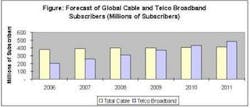iSuppli: Threat to cable MSOs from telco fiber deployments grows
JULY 18, 2007 -- Global telcos want to become multiple service operators (MSOs), offering television programming like cable providers do -- but can they really pose a competitive threat to the incumbent players with their new video services? The answer is yes, iSuppli Corp. (search for iSuppli) believes.
A major reason why iSuppli believes this can occur is the telcos' widespread deployment of all-fiber or deep-fiber access technology, which will help proliferate high-speed broadband capable of supporting rich video services.
Verizon in the United States, NTT in Japan, and France Telecom in Europe are just some of the telcos deploying or planning to deploy fiber all the way to the home. FTTH has the potential to provide subscribers with virtually infinite bandwidth, with which they can receive thousands of HDTV programs, iSuppli says.
"FTTH poses a real threat to the MSOs, potentially rendering today's cable television infrastructure obsolete," said Steve Rago, principal analyst for networking and optical communications with iSuppli Corp. "This is the same infrastructure that cable operators in the United States just finished upgrading at a cost that iSuppli estimates at $60 billion."
The deployment of FTTH will allow the telcos to continue to expand their broadband coverage, bringing it to levels that rival that of cable television service. By 2009, global telco broadband subscribers will rise to 373 million, nearly equal to the 406 million cable subscribers around the globe. The following year, global broadband telco subscribers will rise to 413 million, exceeding the number of cable subscribers for the first time.
The figure above presents iSuppli's forecast of global cable and telco broadband subscribers.
In 2009, 71 million telco broadband subscribers will have very high speed fiber connections that can support an equivalent and potentially superior video service to that provided by MSOs. Of course, not all telco high-speed subscribers will be in regions serviced by MSOs, mitigating the impact.
FTTH now is a competitive threat to MSOs in a few regions where the cost of deployment is not prohibitive, iSuppli says. These regions include Japan, where fiber can be aerial fed from the central office, i.e., using telephone lines or in this case fiber lines strung from telephone poles. Other regions include Verizon's territories in the United States, which are more than 60 percent aerial fed -- and in Paris, where the existing sewer systems provide a low-cost conduit for running fiber to buildings.
For most other regions, the cost of deployment is very high. FTTH deployments in these regions can be between 12 to 15 times the cost of deploying broadband over a telco's copper plant. The cost factor will slow down the widespread, global deployment of FTTH -- but will not stop it, iSuppli believes. Over the next 15 to 20 years, worldwide telcos will bring fiber all the way to homes, the company predicts.
FTTH is not the only threat to cable. Deep fiber penetration, such as a combination of fiber to the curb (FTTC) and VDSL to the home, can compete head to head with cable as well. Not replacing the copper on the last kilometer to the home can save telcos 50 to 65 percent of the cost of provisioning broadband to subscribers. This is the approach used today by AT&T in the United States and several incumbent telephone companies in Europe and Asia. FTTC plus VDSL can match cable television networks in delivering TV service to the home and may offer significant advantages in up-stream applications such as peer-to-peer video.
"MSOs need to start planning now if they hope to counter the threat of telcos starting in 2009," Rago warned. "If MSOs do not upgrade their capabilities, they may see the war for the triple/quadruple play swing in favor of the telcos."
However, telcos need to pass several gates before they can be considered a competitive threat to the MSOs. These include consumers' perceived quality of telcos' TV offerings and the success of their very high speed services.
However, iSuppli does not think MSOs have the luxury to wait until telcos pass these gates. If they do, they may find themselves in the same position the telcos are in today: having to reinvent themselves in order to survive.
Rago's latest report, "Broadband's Next Big Step: Fiber to the Home and VDSL2 and his upcoming report, Broadband Paradigm Shift or Just an Interim Step to Fiber?" provides more information on this topic.
Visit iSuppli

